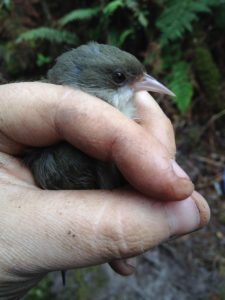Weird and wacky ‘Akikiki breeding behavior
 (From the notebook of seasonal volunteer Liza Olson)
(From the notebook of seasonal volunteer Liza Olson)
One of the highlights (and frustrations) of working with such rare, difficult-to-access species such as ‘Akikiki and ‘Akeke’e has to be the fact that there remains much about their behavior that is still poorly known. Unlike other birds species, where nest monitoring work has been going on for decades and hundreds of nests have been described and monitored, studies on birds like ‘Akikiki are still in their infancy, and the number of nests monitored up to this point in time may only be in the dozens.
Understanding breeding biology is, without argument, one of the fundamental building blocks required to create an effective conservation plan. Luckily, up in the Alaka’i, we learn something new every trip out. Our knowledge databank is always growing.
For example, our field crew was initially baffled by the female at one of our ‘Akikiki nests because she would sit and brood her very old chick for long periods of time (40+ minutes, sometimes), even when it was nearly fledging age. When the chick finally did fledge, the female ‘Akikiki returned right back to the nest and continued to sit, seemingly unphased by the lack of chick! The mystery, however, was solved by the next nest check, when we looked into the nest with our peeper camera to see the nest contents. One egg! So it seems that the female was actually trying to continue to sit on an unhatched egg! Fertility problems may be a possible contributing factor to ‘Akikiki declines, so the presence of an unhatched (possibly infertile) egg in the nest is of interest to us.
Another example of weird ‘Akikiki behavior has got to be the camp male, Orange/Black; Yellow/Aluminum—as his color bands read—but known better simply as the camp male, because we see him pretty regularly around camp. Although we initially thought he had his own mate, lately this male has made a habit of showing up as a third wheel at the nests of other ‘Akikiki! What are you doing, bird? We haven’t observed him actually feeding any chicks or directly going to the nests, just foraging a few meters away. Why don’t the parents chase him away as an intruder? Could he somehow be helping out at the nest site? While so far we haven’t seen any conclusive evidence of cooperative breeding, these observations certainly is enough to raise some eyebrows.



